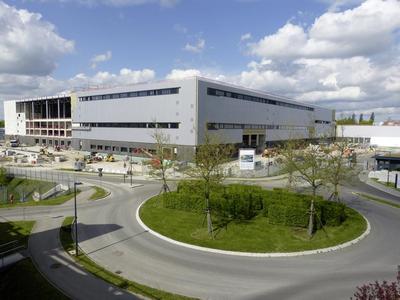Mercedes-Benz Holds Ceremony for the World's Most Advanced Crash Test Facility
 Mercedes-Benz holds topping-out ceremony for the world's most advanced crash test facility, Mercedes-Benz Sindelfingen plant |
SINDELFINGEN -- May 12, 2015: Milestone reached:
construction having begun in July 2013, some 350 guests were today present
at the topping-out ceremony for the world's most advanced crash test
facility. The new test centre measures 270 by 170 metres with an internal,
pillarless test arena – the heart of the crash facility –
measuring 90 by 90 metres to allow even complex junction/pre-accident
situations to be recreated in future. Consequently, the area of the test
arena is considerably larger than a normal football pitch. The facility
will cost triple-digit millions of euros, with the commencement of crash
testing scheduled for autumn 2016.
"As
a safety pioneer, Mercedes-Benz has played a key role in ensuring that
crash tests have today become an established part of the global automotive
industry. Even in the age of computer simulation, crash tests remain
indispensable, guaranteeing the high standards of passive safety in our
vehicles", says Thomas Merker, Director for Body and Safety at
Mercedes-Benz Cars Development. "The new Technology Centre for Vehicle
Safety (TFS) represents a continuation of this pioneering role. The world's
most advanced crash test facility will enable us in future to carry out all
crash tests on our own premises – not just more crash tests due to
the growing product range, but also crash tests with future, new
configurations".
The design of the new facility
allows for collisions with many different angles of impact, including
junction collisions, while also taking into account the particular
crash-related requirements of vehicles with alternative drives. In
addition, Mercedes-Benz aims to use the TFS to further investigate the
potential of PRE-SAFE® and driver assistance systems in the
event of a crash. To be able to recreate the pre-accident phase, the
facility will include an automated driving system for such vehicles. It is
also designed for crash tests with large commercial vehicles. A sled test
unit will also allow the testing of individual components such as restraint
systems.
In total, the TFS will comprise an area
of 55,000 square metres. At the heart of the complex is the 90 by 90 metre,
totally pillarless test arena. The structural features also include
temperature control using the waste heat from the adjacent climatic wind
tunnels. Rotating crash blocks with a different solid barrier on each side
for a particular crash test configuration will in future shorten the set-up
times while making crash testing even more efficient. The same applies to
vehicle measuring, which will be partially automated in future, with the
vehicle being moved on a turntable in front of the camera. Likewise, new
digital measuring technology in the dummies with just one data cable will
take over from the previous analogue technology.
The company is investing triple-digit millions of euros in
the entire facility. The new TFS will in future allow even closer
integration between research, development, planning and production at the
Sindelfingen site. Located in the direct vicinity, a new driving simulator,
new climatic wind tunnels and a new aeroacoustics wind tunnel were taken
into service in 2010, 2011 and 2013, respectively.
55 years of crash testing: Mercedes-Benz as safety
pioneer
The first crash test in the
history of Mercedes-Benz took place on 10 September 1959 on open ground
close to the plant in Sindelfingen, with a test car being driven head-on
into a solid obstacle. Opening a new chapter in safety research at
Mercedes-Benz, this now made it possible for the crash behaviour of both
vehicles and occupants to be studied under realistic conditions using test
cars and dummies. In the decades that followed, Mercedes-Benz has
consistently set new crash-testing standards that have been adopted across
the industry, thereby resulting in permanent improvements to vehicle safety
in the interests of all road users.
Despite
being little used in the early years, from the 1960s onwards crash testing
increasingly established itself as a reliable tool for the optimisation and
testing of vehicle safety. The thorough crash testing regime at
Mercedes-Benz covers not just cars, but also vans, commercial vehicles and
touring coaches. Mercedes-Benz opened its first indoor crash facility in
1973.
The company's crash tests always exceed
the number and complexity of the legally required tests. The current
development programme for new ready-to-produce models comprises around
15,000 realistic crash test simulations and over 150 crash tests.
These include not just the approximately 40 different impact configurations
required for ratings and worldwide vehicle homologation, but also
especially exacting crash tests such as the roof-drop test that are carried
out in addition by the company.


